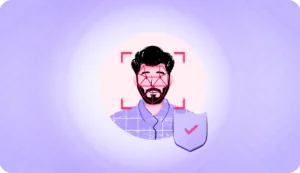When analyzing digital trends, we’ve noticed that the rise of deepfake technology raises important concerns for authenticating users. Deepfakes—highly realistic AI-generated synthetic media mimicking real individuals—have enabled troubling instances of deception and data theft.
Data from the past year shows deepfake fraud affected 26% of small and 38% of large companies, with losses of up to $480,000. Additionally, one-third of businesses reported experiencing deepfake video or audio assaults by April 2023!
Deepfake scams are becoming more common during customer onboarding. It’s important to stay vigilant and take steps to protect yourself and your company. This blog will cover common deepfake scam tactics and strategies to prevent such scams.
Deepfake Scams in User Onboarding
Understanding deepfakes is crucial in the context of user onboarding. Initially developed for entertainment and research, this technology has unfortunately found its way into the hands of fraudsters, posing significant threats in various business sectors, especially during user onboarding processes. Video and audio-based onboarding processes are particularly vulnerable to deepfake manipulation.
Deep learning and neural networks enable the development of highly realistic fabricated ai-generated videos and images known as deepfakes. Their potential for misapplication in the financial services and banking industry is an increasing worry.
Read more:
- What is a Deepfake: Comprehensive Guide To Deepfake Detection
- How Do Deepfakes Work?
Deepfakes in Financial Fraud
Deepfake technology has become a tool for synthetic identity theft and financial fraud. Scammers can use deepfakes to impersonate individuals, creating realistic but fake videos or audio recordings. This capability makes them particularly dangerous in user onboarding, where verifying an individual’s identity is crucial. For instance, they can manipulate identity documents, such as bank statements or government-issued ID cards.
Challenges in Detecting Deepfakes
The realistic nature of deepfakes makes them hard to detect. Traditional security measures often fail to identify these sophisticated forgeries. This poses a significant challenge in user onboarding, where the authenticity of the person being onboarded is paramount.
Read more: How to spot a deepfake
When onboarding new users, employing a multi-step process for authenticating their identities is key to thwarting deepfake deception. Techniques including document verification, biometric verification, and multi-factor authentication observation become critical in this multi-layered approach. Additionally, including deepfake detection as part of the onboarding routine is essential.
Common Deepfake Techniques in Onboarding Scams
Fraudsters who use fake IDs during account registration processes are growing smarter, applying different strategies to fool and mislead people. Let’s examine some typical tactics:
Synthetic Manipulation of Identity Documents
Deepfakes used in such scams during onboarding can alter identity papers in a scary way. They can change existing ones or make new ones using generative AI. These can be hard to tell from real ones. They can change IDs from the government, passports, or driving licenses. The sophistication of these forgeries poses a significant challenge to traditional document verification methods, necessitating advanced solutions like those offered by HyperVerge for reliable detection.
A striking example of the impact of AI-generated images in KYC and onboarding is highlighted in a recent Twitter post. It’s proof of how easily AI can create believable visuals, emphasizing the need for strong deepfake detection systems.

Imitating Important People
This method involves producing deceptive videos or audio clips of high-level staff like CEOs or security managers. For instance, a scammer might utilize a misleading video to mimic the CEO’s voice or look in a video chat, telling an employee to grant access to sensitive systems or to approve a dishonest transaction. This kind of scheme takes advantage of the trust and power related to top positions, making it particularly powerful in bypassing organizational protocols.
In a recent scam, scammers used deepfake technology to pose as the CFO of a Hong Kong multinational company in a video conference call. The company lost a whopping HK$200 million ($25.6 million)!
Fraudulent Communications to Circumvent Confirmation
In this situation, artificially produced media is utilized to create fake audio or video communications that seem to originate from genuine sources. Throughout the enrollment technique, these fabricated communications can be employed to validate false identities or to furnish fake recommendations and endorsements.
Strategies to Prevent Deepfakes in User Onboarding
Fighting deepfake fraud during user onboarding requires a smart plan using tech and people. Here’s a closer look at possible tactics:
Implement Multi-Modal Identity Verification
Multi-modal identity checks use several safety steps to confirm a user’s real identity. This plan includes:
Biometrics: This uses unique body features like fingerprints or eye patterns for identity checks.
Face Recognition: High-tech face recognition compares face details and expressions with saved images to match identities.
Document Checks: This checks if government-issued IDs, like passport verification or driver’s license verification.
Liveness Detection: It is used to fight against fake user attempts. It checks if a user is physically present by tracking real-time actions like blinking or moving the head.
By combining these methods, organizations can create a more secure and foolproof end-to-end identity verification process, significantly reducing the risk of deepfake-related fraud.
Utilize Facial Recognition
Facial recognition techniques are crucial in detecting deepfakes, especially in real-time interactions. These techniques focus on:
Facial Expression Analysis: Scrutinising the fluency and steadiness of facial gestures helps in locating anything unusual that might suggest a deepfake.
Lip Movement Synchronization: It is essential that the lip movements sync flawlessly with the spoken words. This part is often tough in deepfake videos.
Micro-Expression Detection: Detecting fast, involuntary face expressions, which usually align with actual emotions, assists in telling apart real users from deepfakes.
These techniques add an additional layer of security by identifying subtle inconsistencies that are not easily replicable by deepfake technologies.
Leverage Liveness Detection
Liveness check is a critical component in distinguishing real users from synthetic representations. The technology catches life-like features such as random eye motion or facial actions, that deepfakes struggle to perfectly imitate. Liveness detection verifies the person in the onboarding process is really there, not a doctored or recorded image.
For example, HyperVerge’s liveness detection utilizes single-image passive liveness detection which requires a capture of a single image and nothing more. This makes user authentication and onboarding very simple while ensuring that services are protected against any spoofing attempts.

Implement Advanced Deepfake Detection Technology
Advanced detection solutions, like those offered in the deepfake detection space, are vital in the fight against deepfake scams and image injections, particularly in user onboarding. These solutions employ sophisticated AI algorithms to analyze biometric data, assess document authenticity, and evaluate liveness indicators. By integrating these technologies into user onboarding processes, organizations can significantly bolster their defenses against deepfake fraud.
They scrutinize media for signs of manipulation, such as:
- Facial Analysis: Examining facial features for inconsistencies in appearance or movement that are not typical in genuine recordings.
- Voice Pattern Recognition: Analyzing voice patterns to detect any alterations that might suggest a deepfake audio.
- Contextual Inconsistencies: Looking for mismatches between the visual elements and the context or background in which they appear.
Read more: How to detect AI-generated selfies
These tools are essential in detecting content that could be manipulated for identity theft, misinformation, or other fraudulent activities.
AI-powered deepfake detection tools bring several advantages to the table:
- Efficiency: Artificial intelligence algorithms can process large volumes of data at a speed unattainable by human efforts. This rapid analysis is crucial in environments where time-sensitive decisions are needed, such as during user onboarding.
- Accuracy: AI systems, with their ability to learn and adapt, become more proficient over time. They can discern subtle cues that indicate a deepfake, which might be missed by the human eye.
- Scalability: These tools can effortlessly scale up to meet the demands of large organizations, processing thousands of verifications without compromising accuracy or speed.
The battle against deepfakes is dynamic, with fraudsters continually refining their techniques. Therefore, deepfake detection technologies must evolve correspondingly. This involves:
- Regular Algorithm Updates: Keeping the detection algorithms up-to-date with the latest deepfake generation techniques.
- Expanding Training Datasets: Continuously feeding new and diverse data into the AI models to enhance their detection capabilities.
Relevant reads: Are deepfakes illegal?
Conclusion
To recap, the growing issue of deepfake scams poses a major problem for enrolling new users and confirming who they are, irrespective of their background, location, and strength of internet connection.
Want to explore the advanced capabilities of deepfake detection technologies? HyperVerge’s deepfake detection solution can help. HyperVerge can help you proactively identify deepfake scams and keep scammers out in your customer onboarding process.
To combat deepfake scams with advanced deepfake detection, sign up now!






